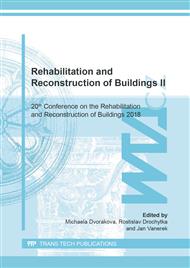[1]
R. Palley, Concrete: A Seven-thousand Year History, W. W. Norton & Company, 2010, ISBN 978-1593720391.
Google Scholar
[2]
L.C. Lancaster, Concrete Vaulted Construction in Imperial Rome: Innovations in Context, Cambridge University Press, 2009, ISBN 978-0521744362.
Google Scholar
[3]
C. Croft and S. Macdonald, Concrete - Case Studies in Conservation Practice (Conserving Modern Heritage), Getty Publications, 2019, ISBN 978-1606065761.
Google Scholar
[4]
Forty, Concrete and Culture: A Material History, Reaktion Books, 2016, ISBN 978-1780236360.
Google Scholar
[5]
I. Seidleorova, J. Dohnalek, Dějiny betonového stavitelství v českých zemích do konce 19. století, Informační centrum ČKAIT, 1999, Praha, str. 328, ISBN: 80-86364-01-1.
Google Scholar
[6]
J.P.P. Guyer, An Introduction to Architectural Concrete, Independently published, 2018, ISBN 978-1980313458.
Google Scholar
[7]
P. Collins, Concrete: The Vision of a New Architecture, McGill-Queen's University Press, 2004, ISBN 978-0773525641.
Google Scholar
[8]
C. Croft, Concrete Architecture, Laurence King Publishing, 2004, ISBN 978-1856693646.
Google Scholar
[9]
P.W. McMulli and J. S. Price, Concrete Design (Architect's Guidebooks to Structures), Routledge, 2016, ISBN 978-1138829978.
Google Scholar
[10]
B. Calder, Raw Concrete: The Beauty of Brutalism, William Heinemann, 2016, ISBN 0434022446.
DOI: 10.1017/arh.2016.21
Google Scholar
[11]
W. Hall, Concrete, Phaidon Press Limited, 2012, ISBN 978-0-7148-6354-2.
Google Scholar
[12]
Ch. Beanland, Concrete Concept: Brutalist Buildings Around the World, Frances Lincoln, 2016, ISBN 978-0711237643.
Google Scholar
[13]
P. Jodidio, Contemporary Concrete Buildings, Taschen GmbH, 2018, ISBN 978-3836564939.
Google Scholar
[14]
J. Margoldova, Beton v architektuře, 18. Betonarske dny, 2011, ISBN: 978-80-87158-30-2.
Google Scholar
[15]
P.Kasal, R. Hela, P. Finkous, V. Lorenc: TP ČSB 03/2018 – Exposed concrete, Czech Concrete Society, (2018).
Google Scholar
[16]
M. Stacey, Concrete: A Studio Design Guide, RIBA Publishing, 2010, ISBN 978-1859463345.
Google Scholar
[17]
R. Pernicova and D. Dobias, Resistance of surface layers of concrete against aggressive environment, Key Engineering Materials, Vol. 722, 2017, pp.44-51.
DOI: 10.4028/www.scientific.net/kem.722.44
Google Scholar
[18]
M. Roth, Concrete Architecture & Design, Braun, 2012, ISBN 978-3037681077.
Google Scholar
[19]
R. Hela, V. Sruma, Technická pravidla ČBS 03 – Pohledový beton, ČBS servis s.r.o., 2009, ISBN: 978-80-87158-17-3.
Google Scholar
[20]
Ch. Van Uffelen, CONCRETE: Pure. Strong. Surprising, Braun, 2015, ISBN 978-3037681893.
Google Scholar
[21]
S. Gaventa, Concrete Design: The Extraordinary Nature of Concrete, Mitchell Beazley, 2001, ISBN 978-1840004045.
Google Scholar
[22]
D. Bennett, Concrete Architecture: Tone, Texture, Form, Birkhauser Verlag AG, 2001, ISBN 978-3764362713.
Google Scholar
[23]
R. Courland, Concrete Planet, Prometheus Books, 2012, ISBN 978-1616144814.
Google Scholar
[24]
J. Dohnalek, Pohledový beton – teorie a realita, Beton TKS, č. 2/2005, Vol. V., ISSN: 1213-3116.
Google Scholar
[25]
P. Claisse, Transport Properties of Concrete: Measurements and Applications, Woodhead Publishing, 2018, ISBN 978-0081014219.
Google Scholar
[26]
D. Bennett, Architectural Insitu Concrete, RIBA Publishing, 2007, ISBN 978-1859462591.
Google Scholar
[27]
D. Phillips and M. Yamashita Detail in Contemporary Concrete Architecture, Laurence King Publishing, 2012, ISBN 978-1780670096.
Google Scholar
[28]
M. Mozny, Pohledové betony v životním cyklu stavby, ČVUT v Praze, 2013, no. 11122.
Google Scholar
[29]
J. Ferrando, Architectural Material & Detail Structure: Concrete, Design Media Publishing, 2016, ISBN 978-1910596524.
Google Scholar
[30]
Tashen, Architecture Materials Concrete, aschen GmbH, 2008, ISBN 978-3836504515.
Google Scholar
[31]
P. Rieger, A. Sterba, Složení a výroba pohledového betonu, Beton TKS, no. 6/2004, Vol. IV., ISSN: 1213-3116.
Google Scholar
[32]
Collepardi M.: The new concrete, Castrette di Villorba : Grafiche Tintoretto, 2010, ISBN 978-88-89037-77-23.
Google Scholar
[33]
M. West, The Fabric Formwork Book: Methods for Building New Architectural and Structural Forms in Concrete, Routledge, 2016, ISBN 978-0415748865.
Google Scholar
[34]
M. Peck, Concrete: Design, Construction, Examples (Detail Practice Series), Birkhäuser, 2006, ISBN 978-3764376314.
Google Scholar
[35]
D. Mettler, Made of Concrete, Birkhäuser, 2018, ISBN 978-3035614459.
Google Scholar


